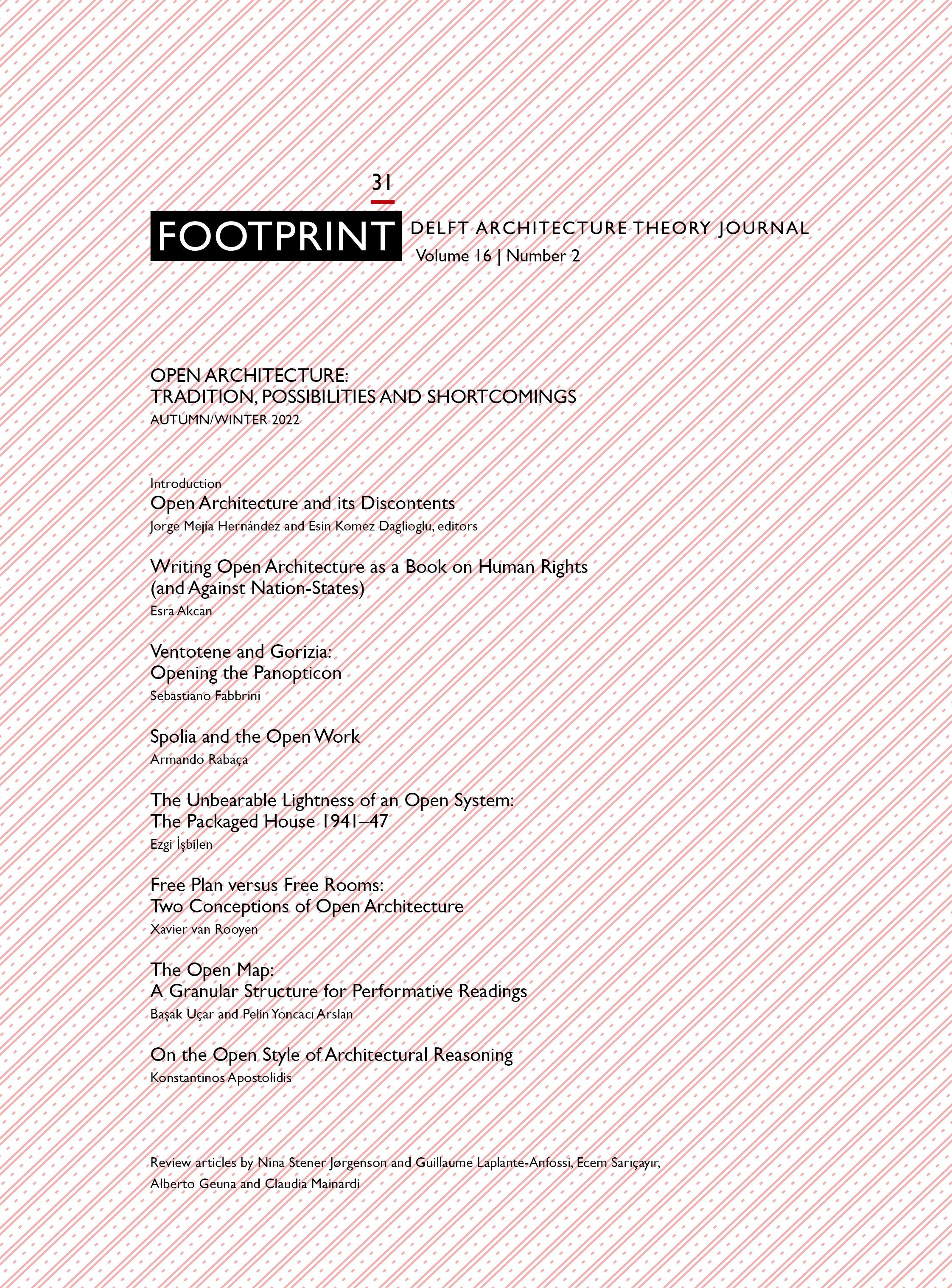The Open Map
A Granular Structure for Ambient Readings
DOI:
https://doi.org/10.7480/footprint.16.2.6068Abstract
Maps are preeminent ways of collecting, organising, verifying, historicising, and even mystifying territorial knowledge. They embrace a multiplicity of readings and readers, and mediate between the visible and the invisible. In constant re-definition, maps transform and maximise themselves by connecting different layers of information and initiating uninterrupted performances. Without delineating a fixed meaning, maps respond to the city’s openness via diversity, incompleteness, and unpredictability. New developments in computer science and information technologies have turned maps into grittier models that define the new granular front of the open map. This article studies open maps in terms of participation and multiplicity, part and whole relationships, and resolution vis-à-vis Jasper Johns’s paintings, Buckminster Fuller’s Dymaxion Map and the World Game, and the MIT’s Real-time Rome project.
References
Alpers, Svetlana. The Art of Describing: Dutch Art in the Seventeenth Century. Chicago: University of Chicago Press, 1984.
Anderson, Virginia M. G. “A Map and a Painting: The Re-Working of Jasper Johns’s Map (Based on Buckminster Fuller’s Dymaxion Airocean World)” American Art 32, no. 1 (Spring 2018): 52–73.
Bodenhamer, David J. “The Potential of Spatial Humanities.” In The Spatial Humanities: GIS and the Future of Humanities Scholarship, edited by David J. Bodenhamer, John Corrigan, and Trevor M. Harris, 14-30. Bloomington: Indiana University Press, 2010.
Corner, James. “The Agency of Mapping: Speculation, Critique and Invention.” In Mappings, edited by Denis E. Cosgrove, 213-252. London: Reaktion, 1999.
Eco, Umberto. The Open Work. Cambridge: Harvard University Press, 1989.
Encyclopedia of the Bible and Its Reception vol. 13. Walter de Gruyter, Berlin/Boston, 2016.
DeLanda, Manuel. Intensive Science and Virtual Philosophy. New York: Continuum, 2002.
DeLanda, Manuel. Assemblage Theory. Edinburgh University Press, 2016.
De Mallac, Guy. “The Poetics of the Open Form: (Umberto Eco's Notion of "Opera Aperta").” Books Abroad 45, no.1 (Winter 1971): 31-36.
Doob, P. Reed. The Idea of the Labyrinth from Classical Antiquity through the Middle Ages. Cornell University Press, 1992.
Fuller, R. Buckminster. “Fluid Geography.” In The Buckminster Fuller Reader, edited by Richard Buckminster Fuller and James Meller, 126-139. London: Cape, 1970.
Fuller, R. Buckminster. ‘World Game.’ In Critical Path. 198-228. Estate of R. Buckminster Fuller, 1982.
Husserl, Edmund. “Investigation III – On the Theory of Wholes and Parts,” Logical Investigations, vol.II. Trans. J.N. Findlay. London: Routledge, 2001:1-45.
Graafland, Arie. Understanding the Socius through Creative Mapping Techniques. TU Delft: DSD., 2008.
Johns, Jasper, Kirk Varnedoe, Christel Hollevoet. Jasper Johns: Writings, Sketchbook Notes, Interviews. New York: Museum of Modern Art, 1996.
Kern, Hermann. Through the labyrinth: designs and meanings over 5,000 years. Munich: Prestel, 2000 (reprinted from the original 1982 edition).
Koehler, Daniel. ‘Mereological Thinking_Figuring Realities within Urban Form’, Architectural Design 89, no. 2 (2019): 30-37.
Macy, Christine, Sarah Bonnemaison, Architecture and Nature Creating the American Landscape. New York: Routledge, 2003.
Michalatos, Panagiotis. “Design Signals: The Role of Software Architecture and Paradigms in Design Thinking and Practice,” Architectural Design 86 (2016): 109–115.
Namuth, Hans and Judith Wechsler, director. Jasper Johns: Take an Object. 1990. 26 min. https://judithwechsler.com/films/jasper-johns-take-an-object.
Pearson, Mike, Michael Shanks. Theatre/Archaeology. Routledge, 2001.
Presner, Todd, David Shepard, Yoh Kawano. Hypercities Thick Mapping in the Digital Humanities. Harvard University Press, 2014.
Ramsey, Joseph. “A Fuller Map: Latent Meanings within Jasper Johns’ Map (Based on Richard Buckminster Fuller’s Dymaxion AirOcean World)”, Athanor 35 (2017): 77-84.
Scott, Timoty. Buckminster Fuller’s World Game and Its Legacy. Routledge, 2021.
Sherr, Lynn. “Expo 67,” Art in America 55, no. 1 (January 1967): 76–79.
Young, Mahonri Sharp. “O Canada! O Expo!,” Apollo 86, no. 67 (September 1967): 234–38.
Downloads
Published
Issue
Section
License
Copyright (c) 2023 Başak Uçar, Pelin Yoncacı Arslan

This work is licensed under a Creative Commons Attribution 4.0 International License.
- Authors retain copyright and grant the journal right of first publication with the work simultaneously licensed under a Creative Commons Attribution License that allows others to share the work with an acknowledgement of the work's authorship and initial publication in this journal.
- Authors are able to enter into separate, additional contractual arrangements for the non-exclusive distribution of the journal's published version of the work (e.g., post it to an institutional repository or publish it in a book), with an acknowledgement of its initial publication in this journal.





